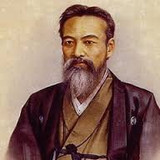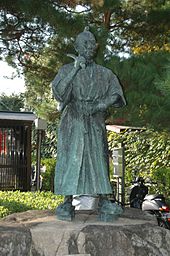Yamaoka Tesshu 1836 – 1888

Yamaoka Tesshu 1836 – 1888
“Ken-Zen-Sho”

Yamaoka Tesshū, was a famous samurai of the Bakumatsu period. He is also noted as the founder of the Itto Shoden Muto-ryu school of swordsmanship. His life bridged the time between feudal and modern Japan.
Yamaoka was born in Edo (present-day Tokyo) as Ono Tetsutaro.
 From an early age,
Yamaoka showed dedication and talent in the practice of martial arts.
He practiced swordsmanship from the age of nine, starting in the Jikishinkage Ryu tradition. After that he learned Hokushin Ittō-ryū
from Inoue Hachirō, who was asked by
Yamaoka Tesshū's father to teach his son. Later he
began the Nakanishi-ha Ittō-ryū
style of fencing.
From an early age,
Yamaoka showed dedication and talent in the practice of martial arts.
He practiced swordsmanship from the age of nine, starting in the Jikishinkage Ryu tradition. After that he learned Hokushin Ittō-ryū
from Inoue Hachirō, who was asked by
Yamaoka Tesshū's father to teach his son. Later he
began the Nakanishi-ha Ittō-ryū
style of fencing.
Tesshu was one of the most remarkable swordsmen of the nineteenth century. Indeed, his place is assured among the greatest swordsmen of Japanese history, though he never used his sword in anger. A devotee of Zen, accomplished artist and calligrapher, he studied a number of ryu over the years. He received the full transmissions of Ono-ha Itto-ryu and Nakanishi-Ha Itto-ryu from their respective headmasters. He created his own line of transmission, named Itto Shoden Muto-ryu to emphasize that he was passing on the correct transmission of Itto-ryu principles and techniques. The term ‘Muto” (No-Sword) refers to the realization he obtained through years of meditation, that the difference between Sword and Self, and between oneself and one’s opponent, is illusory and that the underlying unity of all is the most important thing in swordsmanship.
 Muto-ryu kata resemble
those of its two parent Itto-ryu styles with what appears to be an a mixture of
elements from Jikishinkage-ryu, which Yamaoka is also said to have
studied. There are over fifty techniques
in the ryu’s curriculum, similar to Itto-ryu in general. As in those schools, the uchidachi (attacker)
wears the onigote (thickly padded gauntlets); the bokuto (wooden swords) used
are fairly straight and heavy. An
unusual feature of some Itto Shoden Muto-ryu kata is the stance taken on one
leg, taken from Jikishinkage-ryu. The
Itto-ryu principle of one technique which
becomes ten thousand techniques, is in accord with the most fundamental
principles of combat.
Muto-ryu kata resemble
those of its two parent Itto-ryu styles with what appears to be an a mixture of
elements from Jikishinkage-ryu, which Yamaoka is also said to have
studied. There are over fifty techniques
in the ryu’s curriculum, similar to Itto-ryu in general. As in those schools, the uchidachi (attacker)
wears the onigote (thickly padded gauntlets); the bokuto (wooden swords) used
are fairly straight and heavy. An
unusual feature of some Itto Shoden Muto-ryu kata is the stance taken on one
leg, taken from Jikishinkage-ryu. The
Itto-ryu principle of one technique which
becomes ten thousand techniques, is in accord with the most fundamental
principles of combat.
Today, there are few exponents of Yamaoka’s school, most likely because its training methods are so severe. In recent years a book based on his thoughts and calligraphy Ken Zen Sho in English has become a popular book by traditional Japanese martial artists written by Dr. Alex Bennett.
The day before his death, at age 53, Tesshu noticed no sounds of training to be heard from his dojo. When told the students had cancelled training to be with him in his last hours, he ordered them to return saying: “Training is the only way to honour me”.
In anticipation of his death, Tesshu composed his death poem first, then sat formally and closed his eyes, slipping into death.
